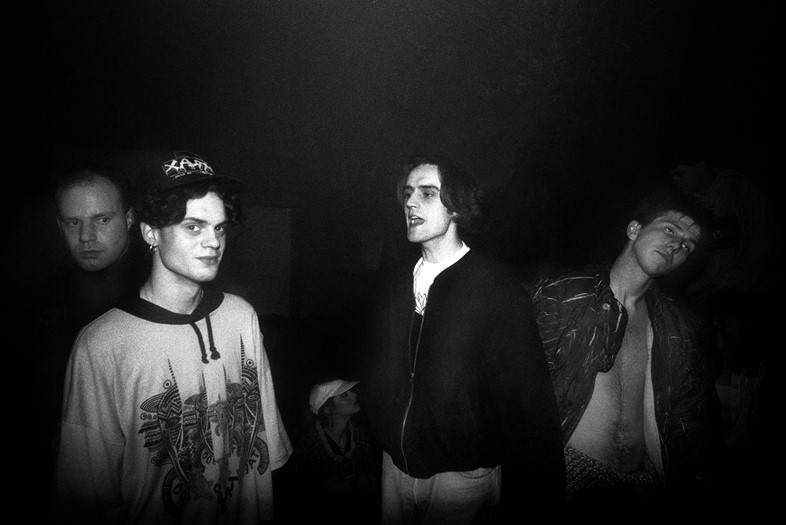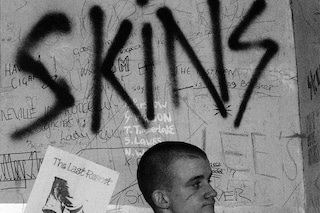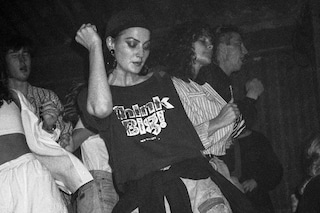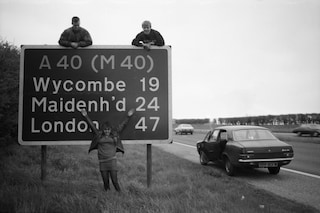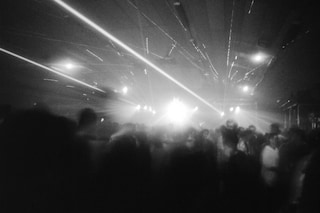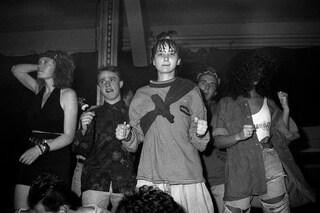From skinheads to 90s ravers, photographer Gavin Watson discusses Britain’s most important youth movements
‘I didn't feel my photographs were important but I felt that what was happening around me was unbelievably important and exciting. I was just amazed that we were demonised instead of celebrated’. Spanning 35 years, photographer Gavin Watson’s iconic collection provides us with one of the only photographic records of some of the least documented of British subcultures – from capturing the tattooed young men in bovver boots of the 1980s British skinhead movement, to the halcyon days of 90s rave.
Tomorrow night, YOUTH CLUB, a non-profit organisation working to preserve, share and celebrate youth culture history will launch a website showcasing Watson’s unseen archive of 20,000 photos as part of their Preservation Programme. Alongside this, the NFP has teamed up with Dalston’s Doomed Gallery to host a one-off talk and zine by Watson entitled “Time Has Creative Power”. To find out more about the project and the story behind Watson’s pictures, we caught up with the photographer to discuss the importance of British subculture in the last 30 years.
Did you feel at the time you were recording something important?
Gavin Watson: I had a very strong sense that something important was happening but I thought that was just me until now, until I realised when people look at the photographs, that I was fucking right, something mental was going on... even though they tried to ignore us out of existence. This country hates its youth, it really does. Back then no one gave a flying fuck about it, like who gives a fuck about them? They're just street kids, chavs, who gives a fuck about chavs? It was the same with raving, fucking the same. I was like ‘can’t anyone see what's going on here?’ No one was interested in my stuff until I was 40-years-old. I was ignored and laughed at until it suddenly became a golden era and it was like ‘look what this guy’s done’.
How did it feel back then? What was the atmosphere like?
Gavin Watson: It seemed crazy to me (that) there was a revolution going on and no one could see it. Madness and The Specials, black and white – it was fresh and new and exciting. It had the energy of punk, but it was better than punk to me. There was a new generation of mixed raced kids involved in the whole thing. We were just kids trying to find our way in life. For me, I was just trying to keep out of fights and taking pictures when I felt like taking pictures, out of the pure joy of the love for my friends and the love of what was going on around me. I was very passionate about it because I believed they were something special. Towards the end, I thought I was nuts, because no one else could see it. But now they do.
There's so much misunderstanding about what that era was about, the schizophrenia of it all. One minute you'd see these kids crying and the next they'd be dancing to ska. What is fucking going on? It’s difficult to put modern sensibilities on something that was so divided. National front was a real solid political party back then, funny when you see Europe now going through what England did then, the same rhetoric. These photos are a result of those divisions. I grew up in a multicultural society, whereas my parents didn’t. It was an interesting time. I got kicked out of school with no education and now I’m an anthropologist.
“It seemed crazy to me (that) there was a revolution going on and no one could see it’”– Gavin Watson
How did the media react to your photos?
Gavin Watson: I was the only skinhead to stand up and say 'I’m a skinhead and I created this', until Shane Meadows (director of This is England). After the pictures were published, the big papers sent their attack dogs after me – their top fucking journalists to find some sort of unseen political agenda I had as a 15-year-old, uneducated kid from the backwater of High Wycombe. These were university-educated journalists writing from an agenda that was over 20-years-old. Because I was a white kid from a council estate, I must have been racist. I used to say to them, ‘if I was a fucking Nazi, I'd tell ya. And if I was proud of it, I'd tell ya’. But unfortunately I wasn’t, because it wasn’t in my nature and it wasn’t my reality. I was angry and vicious, but I didn't understand the attitude towards women, and I didn’t understand racism.
You’ve been cited by This is England director Shane Meadows as one of the key visual influences for his work. What’s the relationship between your work and Meadows’?
Gavin Watson: I was living in Brighton the year before he made This is England and I heard he might want to use my images. But when the film came out, I realised why my photos never went anywhere near it. I spent years trying to get away from that shit. It was heavy, fucking heavy. The photos don't show that. The film has been a Godsend. Watch Shane Meadows’ film if you want to know what it was like. I had lost most of my mates by the time I was 23. All I wanted was to get out. All my mates who were creative who could’ve done something with themselves, all the rebels and artists, they all died early from drugs and shit. We were only 30 miles from London, but we might as well have been in Outer Mongolia. Shane Meadows is so important to putting some truth out there, he gave me such an important platform and it was nice to have someone else out there to go ‘yeah this is what it was’, instead of just me.
Why do people want to see the pictures and hear the stories now, rather than ten years ago?
Gavin Watson: There seems to be a yearning for authenticity amongst young people today. There’s no zeitgeist of today; everything is regurgitated. There’s no natural root, just ideas contrived and controlled by marketing companies. Those grassroots movements that came out like punk, skinheads and ravers, and a little bit with grime as well, there’s a lack of them today – I think it's a yearning for that time, a 'golden era‘. I don't believe in golden eras, nothing changes, really. For me, it's all about a sense of authenticity, a sense ‘this has happened to me.’
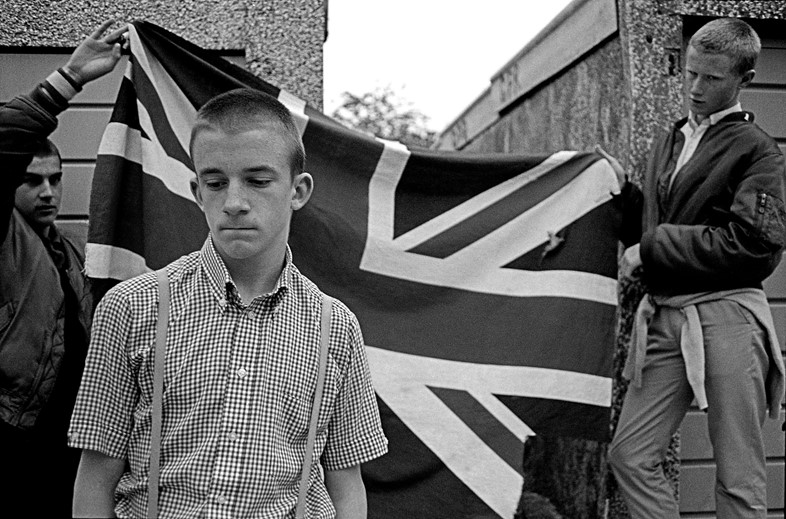
Do you think we need another movement today?
Gavin Watson: I don't know. We certainly didn't need the gang warfare and violence back then that sparked it all. That's what people don't realise – it was fucking horrible, mate. People don't look at their history – these groups grew from stuff that happened 20-years-before, it was a militaristic nation. You have to look at society: these groups come out of poverty. There is still poverty around, but it's not the same – the ingredients aren't there really for why a group of people would define themselves how they did. Except for the grime kids, maybe. It’s about saying who you are, it's a reaction against something. with the world the way it is, what is there to rally against? There doesn’t seem to be the energy.
The skinhead pictures were ones of your brother and your friends, but what about the rave pictures? What was the reaction to you with your camera at raves?
Gavin Watson: That's interesting. I was actually hired by the rave to take the pictures. I used to go out raving with all my friends, they used to call us the 'acid skinheads' before we grew our hair. I had been a skinhead for 10 years and so no one was gonna fuck with me, but the paranoia was unbelievable and I hated it. I wanted to go raving. I didn’t want to take a great big Nikon down there with a flash attached, it was a pain the arse. But, of course, I'd get in for free and I was always skint. I was lucky because I was asked to do them and I wasn’t scared of much – I was with my mates. There are hardly any pictures of raves. It's fucking mental! Fantastic!
What did you feel about those photos?
Gavin Watson: When I saw the rave photographs I thought ‘these are shit, you're off your head on three E’s, I can’t use your photo.’ And it was so hot in there! My skinhead pictures were beautifully composed, quite traditional pictures, and the raves ones were all fog and blurred. But when I started working at Vice and I looked back on them I thought, 'oh my God' – because I had started to look at things differently. I learned to love them. The rave thing was really important, punks, gangs of hooligans, skinheads, rockabillies, raving wiped all that away. Raves were nuts, to have that level of freedom. I used to stand in a fucking field just feeling fucking sorry for the people that weren’t there to witness it or be part of that absolute revolution. Rave is more punk than punk ever was, because kids didn’t even think about breaking the law, they just wanted to get to a rave. The spirit was amazing.
“I managed to record my journey, which was thousands of kids’ journeys, all kids’ journeys, and that's what the work shows really. Those relationships. They’re just young teenage kids trying to find their way in life” – Gavin Watson
How and why did you get involved in the project?
Gavin Watson: YOUTH CLUB grew directly out of the PYMCA (Photographic Youth Music Culture Archive, a specialist image and research library for global youth culture, lifestyle and music) which I've been involved with since 99. They understand youth culture and photography; bigger agencies would be more sterile. It's important that photography involved in youth culture is under one umbrella, it’s important to keep it focused, to make sure it's represented as an actual important part of British culture. Doing these talks helps me understand a little bit more about what it means to me. I look at those pictures and I feel removed from them – they are becoming amazing to me. My dad ‘son, you've got to wake up to the fact that this stuff is popular and people like it and want to know about it. You can't hide away from it.’
Where did the name of the talk come from?
Gavin Watson: I was literally bored and sitting around, most of those pictures were taken out of the back door of my kitchen and up and down the road. It's fascinating to see the mundane – my mundane life – become something totally different and powerful. That's it basically. To see that transition, to witness something mundane that no one’s interested transition to something people are fascinated by. These photos represent a time that's gone: no mobiles, no computers, kids had to fucking do stuff, go out and make relationships and bounce off of each other. There was no sitting in the house, you don’t want to sit in the house with your parents – Jesus Christ! It's not about skinheads really. The skinheads label, it doesn't annoy me but it's not right because we were just kids dressed up in clothes. We could've been anything, a few years later we would've been something else. I managed to record my journey, which was thousands of kids‘ journeys, all kids‘ journeys, and that‘s what the work shows really. Those relationships. They're just young teenage kids trying to find their way in life.
“I just want people to see a beautiful picture. I’ve only ever been interested in taking good photographs that people can look at. Some are beautiful. That’s all that matters” – Gavin Watson
Is there one picture that stands out to you from all the rest?
Gavin Watson: It's difficult because I don't attach myself to them. But the one that does jump out to me is the one of the kid on the tube with the cigarette. I just gets better and better! The composition…it just looks unreal. No styling, no nothing. He doesn't give a shit. The look on his face, he'll fucking tell you. It's just wicked.
What do you want people to take away from your photo collection?
Gavin Watson: You know what it was? Pictures of my mates. We shouldn't be talking about photography. Pictures paint a thousand words and every viewer can take whatever they want from it. I have no ownership of that, I don't think about it, I’m not self-obsessed. But maybe just the spirit of it? The raw spirit of youth. Hopefully that comes across. I don’t want to say it was better back then, because it wasn’t. Nothing changes in history, it just goes round and round and round. I just want people to see a beautiful picture. I've only ever been interested in taking good photographs that people can look at. Some are beautiful. That's all that matters.
“Time Has Creative Power“ will be on at the Doomed Gallery on Tuesday 5th April at 6.30pm. Click here for the facebook event.
